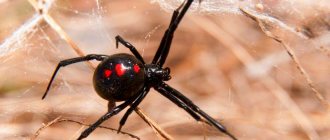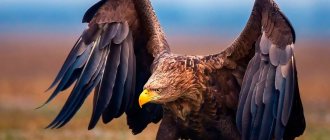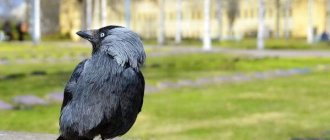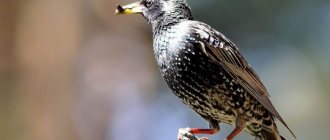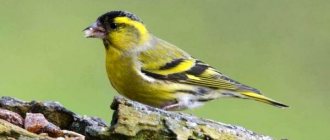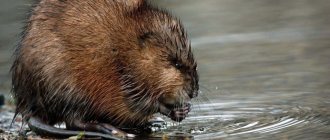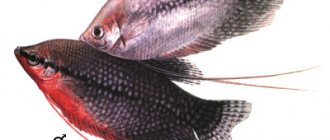What is a female black grouse called?
Children can answer this question in an intricate way: black grouse, black grouse. You can, of course, simply call her a female black grouse. What is the name of this chicken-like bird? It is correct to call her a grouse. In ancient times, it was called the grouse grouse because of its external resemblance to the pockmarked chicken. Fishermen and hunters call it hoof.
In general, it’s easiest to just call her a black grouse. This is what we will write in the future in the article.
Little-known facts about black grouse
The black grouse has many natural enemies. Adult birds are caught by martens, sables, foxes and hawks; nests are destroyed by foxes and wild boars. Chicks die from attacks by hawks and sables. But all this does not harm the grouse population.
Deforestation leaves fewer and fewer places suitable for nesting. Black grouse die at the hands of hunters, and their chicks die without parents. Many people are chased down by dogs while hunting. This poses a serious threat to grouse. In some countries they have already disappeared, there is a danger that they will become extinct due to hunting.
The article was read by 1,808
Black grouse: forest beauty
This is a special bird. He is distinguished and luxurious, dressed in a luxurious fur coat of feathers.
It can be easily recognized by its dark black plumage with a mirror-like shine. The bird's neck may have a green or purple tint. The abdomen is brown in color. The tips of the tail feathers are gracefully curved. There are white feather inserts on the wings, and red eyebrows above the eyes.
The black grouse is a real decoration of the forest expanses, but it is hunted for real. The meat of this bird is valued, not its beautiful appearance. Every year, fishermen exterminate entire flocks of these creatures. Experienced hunters, at least, do not touch the grouse, realizing that they may have a nest with chicks. Poachers do not think about the defenseless brood of chickens; they only care about the fact of capture.
Species of grouse
Today the grouse family consists of 17 species , united in 8 genera, which include:
- Bonasa (hazel grouse) – common, collared and Severtsova;
- Centrocercus (sage grouse) – common sage and Centrocercus minimus;
- Dendrapagus (blue grouse), which includes its species of the same name;
- Falcipennis (grouse) – common and Canadian;
- Lagopus (white partridge) – common, white-tailed and tundra;
- Lyrurus (grouse) – Caucasian and black grouse;
- Tetrao (grouse) – common and stone;
- Tympanuchus (grass grouse) – common meadow and sharp-tailed grouse.
Appearance of the grouse
What does a female black grouse look like? Unlike males, they are not as noticeable. The grouse is similar to a regular chicken, only it is much larger.
Its color is brown or beige; black and light longitudinal stripes of feathers are clearly visible in its plumage. It's sort of striped and motley.
The black grouse can also be confused with a female capercaillie. They are similar in size and plumage. The grouse has white “mirrors” on its wings, and its undertail plumage is also white.
Chicks, both females and males, are identical in appearance. They are bright and colorful. Their plumage contains brown, black, red, white and brown feathers.
A female black grouse can hide from hunters more professionally thanks to her inconspicuous plumage. She is practically invisible in the thick grass, where she will certainly run away to escape death.
Grouse
- home
- Articles
- Encyclopedia of Animal Species
- Wild birds
- Grouse
- Content
- Spreading
- Genus Lyrurus grouse
- Appearance
- Behavior and lifestyle
- Nutrition
- Species of grouse
- Reproduction
- Sources
What names are not given to the black grouse? Hunters call it blackhead, field rooster (apparently due to its relation to the order Galliformes), birch grouse (as an inhabitant of birch or mixed forests), kosach (this is the name of a separate species of black grouse), and polnik. Such affectionate names are also available in the hunting lexicon for the female black grouse: black grouse, killer whale, pole, marakushka, hazel grouse (for its variegated coloring) and polynyushka. The female and male black grouse are noticeably different in appearance. Males are usually quite large, they can weigh up to one and a half kilograms, and females rarely reach a kilogram and are variegated, but not so brightly colored. In appearance, the black grouse, indeed, is somewhat reminiscent of a domestic chicken - it has the same loose and densely feathered body, and the fleshy red eyebrows near the eyes from a distance look like a bright cockscomb. For their habitat, black grouse most often choose birch forests, but not dense ones, but alternating with grain fields. Male black grouse can also sing; they demonstrate this skill especially clearly during the mating period. And their song also resembles the crowing of a rooster. The rest of the time, the black grouse “gurgles” and these sounds often attract hunters. These birds prefer to live on the ground, but are able to easily fly long distances, but they never rise high.
Distribution Black grouse live in forest and forest-steppe zones of Europe, Asia and North Africa. They are especially common in Central Europe and Asia, and are also found in Scandinavia and Great Britain. In Western Europe, black grouse prefer to settle in the mountain forests of the Ardennes, the Alps, the southern Carpathian Mountains, the Czech Republic, the southern Balkans, and also choose the heathlands of the Netherlands, Belgium, Denmark and northern Germany. The Asian distribution range of grouse includes northern Mongolia, northeastern China and Korea. Throughout Russia or in adjacent areas, black grouse are settled near various reservoirs or in river valleys. In the north these are the Kola Bay, Umbozero, the Ponoy and Pana rivers, Varzuga, Strelna, Nes, Mezen, Sula, Usa, Sob, Ob, Kataramb lakes, the Middle Vilyuy basin, Lena, May, Yudoma, northern Baikal. In the south, the range of black grouse reaches the valley of the Ussuri River and Lake Khanka, but nowhere does it reach the Pacific coast. To the west of the Altai Mountains, the habitat of black grouse breaks up into separate isolated areas associated with large forests or vegetation on river banks. But, unfortunately, in Soviet times, when agriculture spread to the steppes and forest-steppes of Europe, Kazakhstan, and Siberia, the number of black grouse in these territories decreased noticeably. Today, the Caucasian black grouse is even listed in the Red Book as a species on the verge of extinction. From the point of view of natural conditions, this bird prefers groves and copses alternating with open spaces. In the mountains, black grouse can be found only in sparse tree vegetation, and in the taiga, in clearings and clearings, sometimes black grouse settles in shrub groves.
Genus Grouse Lyrurus Kingdom: Animalia Phylum: Chordata Subphylum: Vertebrates Class: Birds Subclass: Novopalates Order: Galliformes Family: Pheasantidae Subfamily: Grouse Genus: Grouse Species: Caucasian grouse (Lyrurus mlokosiewiczi), Black grouse (Lyrurus tetrix)
Appearance There is no mistaking a female and a male black grouse. Roosters are predominantly dark or even black with a violet-blue tint of feathers on the head, neck, lower back, rump and chest. On the wings and under the tail there are areas of white plumage, otherwise called “mirrors”. The feathers on the back usually take on a brown tint with occasional patches of long white feathers. The wings of the black grouse are black-brown, and on the throat there is a large white spot with a transition to the sternum. The male's beak and legs are dark, the fingers are covered with a horny fringe, and the tail ends with feathers strongly curved upward and to the sides, which is why its shape is sometimes compared to a lyre. Above the eyes there are thick, red downy feathers that form a crest on the head. The color of the female is dominated by red, dark and brown colors, the chest is motley with alternating yellow-brown stripes, there is also a white spot on the throat, and the abdomen has a whitish tint. The panties - that is, the plumage of the metatarsus - of the female black grouse, unlike the male, are also usually light. A grouse “girl” can easily be confused with a female capercaillie. Its distinctive feature is only the white “mirrors” on the wings, which become noticeable only during flight. As they grow older, black grouse of both sexes manage to change their outfit several times, but only slightly - from light to dark tones. The sizes of male black grouse are standard: body length 50-70 cm, wingspan 80-80.5 cm, wing 25-30 cm, tail 9-11 cm. Females, naturally, are a little smaller, but not much. Grouse are characterized by seasonal changes in weight, but much, of course, depends on the abundance of food and living conditions.
Behavior and lifestyle The black grouse is a social bird. It is characterized by existence in groups. This is especially noticeable in winter - then females and males stick together. Towards the end of the cold weather, especially in early spring, when the vegetation is still sparse, in the mornings and evenings black grouse climb trees to feast on young shoots, buds, catkins, and sometimes, in order to get some particularly attractive delicacy, they cling tightly to a branch with their paws and hang down head. In the evening, after eating, black grouse fall straight from the tree into the snow and break through it, forming a hole, burrowing into which they spend the night. If you startle a bird hiding in the snow, it can fly out, breaking through the snow again and leaving wing prints on the sides of the hole. The black grouse does not like frost, so in extreme cold it can hide under the snow for a whole day. At this time, the bird flies out to feed approximately twice a day, and when the snow crust hardens, the duration of feeding increases. As spring approaches, female grouse separate from the males. And when the sun begins to warm up, the birds fly out into open places and begin to make sounds, which become louder and more insistent with each spring month and the approach of mating. Black grouse almost never change the current, organizing mating games in the same place every year. This is how hunters most often find them when scouting these places. However, the black grouse is incredibly careful, it has excellent hearing and vision, and on the ground it moves deftly and quickly.
Food In winter, as already mentioned, the main food of black grouse consists of tree shoots, buds, and birch catkins. However, the winter diet also depends on the habitat of the birds. In the north, black grouse feast on blueberry stems, larch shoots, and rhododendron leaves. In coniferous forests they eat pine needles. In Siberia, the food of black grouse consists of the same pine needles and cones, berries and juniper needles. In other territories, black grouse prefer rose hips, willow, aspen, and alder buds. With the onset of spring, the birds get to last year's berries and the first vegetation, and in the summer the basis of their food consists of various seeds, leaves and berries of lingonberries, blueberries, blueberries, bird cherry, clover leaves, and ripened sedge seeds. If the black grouse lives near agricultural land, it feeds on grain crops. Parents feed young chicks with small insects. Throughout their life, black grouse need gastroliths - hard seeds and small stones.
Types of grouse There are two main types of grouse known in nature: Caucasian grouse (Lyrurus mlokosiewiczi) and black grouse (Lyrurus tetrix). Only the Kosach has subspecies. The Caucasian black grouse is included in the IUCN-96 Red List and is protected in many southern nature reserves. In appearance, it is similar to the common grouse or black grouse, differing only in the smaller size and shape of the tail, which in the Caucasian grouse is more noticeably curved to the side. This bird lives in many former Soviet republics - Georgia, Armenia, Azerbaijan, of course, in the Caucasus, as well as in Turkey. The black grouse has a typical description for representatives of the genus. Its double name is explained by the structure of its tail, the feathers on which resemble black braids. Some subspecies of black grouse are attached to certain habitats. Only seven such subspecies are known: L. tetrix tetrix, L. tetrix britannicus, L. tetrix viridanus, L. tetrix mongolicus, L. tetrix ussuriensis, L. tetrix tschusii, L. tetrix baikalensis.
Breeding Black grouse choose mainly open places for mating and can return to them for many years. Usually the number of males per mating area is 10-15 individuals. Sometimes entire populations of black grouse have one main and several reserve leks. There, on the main lek, a flock is formed in the fall. The breeding season for black grouse begins in March. Preparations for the mating ceremony begin with the males singing. At first they sing right while feeding, being in a flock. But gradually the intensity of singing increases, and male black grouse begin to gather at the mating area. During this period, males are aggressive, although they do not mark their territory in any way, but actively protect the space around them from the encroachments of others. Fights also happen. Unfavorable weather can also affect mating, and then it stops for a while. In general, mating lasts about two weeks. The black grouse begins to attract a female even before dawn, but the “girl” appears on the mating area also in the dark. Old males give the “start” to mating. Each black grouse displays in its own area, and the females try to position themselves closer to the center, where the most males accumulate. The strongest and most mature black grouse also occupy the central areas of the lek. Black grouse are polygamous. One male at a mating site is capable of fertilizing many females. During the current, the black grouse extends its neck forward, lowers its head and fluffs its tail. The marriage ceremony also includes special jumping and demonstration flying around the area. Sometimes fights between females occur during mating, for example, if an inexperienced grouse accidentally approaches an older “girl” who is preparing to mate. After mating, it is time to build a nest. The black grouse sets it up in a shelter, on the ground, under trees or in the grass, and only occasionally in open space. The female lays 7-9 large yellow speckled eggs in the nest and incubates them for a little less than a month, periodically turning them over during the process. The expectant mother flies out of the nest to feed no more than 3 times a day, and before the chicks hatch, she can stay in the nest for up to 20 hours. The chicks hatch in a few hours, weigh no more than 30 grams and leave the nest almost immediately. The wandering of the brood with the mother also occurs for about a month.
Sources https://www.huntig.ru/ https://www.allhunt.ru/ https://winter-birds.narod.ru https://ru.wikipedia.org/ https://www.piterhunt. ru https://www.floranimal.ru
Health to you and your pets!
© 2021 Team “ZOOVET” We are always happy to help you! 24-hour consultation: +7 Make an appointment [email protected]
Return to list
Black Grouse Weddings
With the onset of early spring, black grouse begin to burst into song - to lure and attract females to start a family. The black grouse cooes and snorts for several minutes, then calms down for a short time and begins to sing again.
The female black grouse clucks, teasing the suitors and inciting more and more excitement in them. It is the grouse who chooses her grouse.
The males coo and wait for the grouse to separate them, each making their own choice. Females are in no hurry to run to their suitors; they bide their time until the last minute. During this time, the most persistent, and therefore the strongest, representatives of the bird flock are determined.
When the choice is made, the black grouse separate into pairs and disperse to their territories. They stay together for some time before the black grouse lays her eggs. At this time, the male also visits other grouse who are left without a mate. The female black grouse has nothing against such trips, because they are polygamous birds.
When the eggs are in the nest, the black grouse leaves the area. The males flock together again until the next season.
The grouse incubates the clutch alone, protecting future chicks from the encroachment of predators and other lovers of bird eggs.
Description of black grouse
This is a fairly large bird. It has a small head and a short strong beak. The black grouse belongs to the order Galliformes and resembles a chicken. Its wings have long feathers that serve as rudder in flight. This can be seen more clearly in the photo of the black grouse below.
Female and male individuals have completely different colors, so it is not difficult to distinguish them from each other. Let's look at their features in more detail.
Hatching and hatching eggs
As already mentioned, males do not take part in the future fate of their offspring. The female black grouse arranges the nest herself, trying to build it in thick grass, thickets of nettles or junipers.
Typically, the black grouse lays 6-8 eggs, which it takes care of for a month. After 25-30 days, the chicks hatch, but they are not the same as ordinary chicks. Within a few hours they leave the nest and follow their mother everywhere.
During the first ten days of the chicks' life, the female black grouse does not take her eyes off them. At this time, she herself is exposed to the greatest danger.
Chicks do not yet know how to fly; they cannot sense danger and defend themselves. And danger awaits them at every step. They are threatened not only by hunters, but also by wild animals.
If the mother grouse senses danger, she immediately emits a loud cry, similar to both clucking and the roar of a wounded individual at the same time. The chicks know what this means: run away immediately, hide in the grass and sit quietly!
The female black grouse herself pretends to be wounded and takes the dangerous representative of the outside world away from her children.
Once again, when you are hunting grouse and see a wounded grouse, think about it: maybe she is simply leading you away from her nest. Do not touch this bird, because without it the chicks may die.
Grouse and grouse live inseparably, even when the chicks begin to fly. After ten days they begin to jump and flutter, and after a month they fully stand on their wings.
The female black grouse takes her children out to meet the entire flock only closer to wintering.
Reproduction and lifespan
The mating period begins in early spring, when the snow begins to slowly melt. Males use characteristic sounds and a peculiar dance to invite their chosen ones for mating. Fighting often occurs during the mating season.
They are reminiscent of those staged by bank roosters, but in the case of grouse, all, fortunately, remain alive. This is a truly amazing and incomparable spectacle. You can personally verify this by watching a video or photo of such an unusual process.
Males spend maximum of their strength to win the attention of females. At the same time, they are so polygamous that during the breeding season they fertilize several dozen females. Also at this time they are quite timid and silent. But there are reasons for this: due to molting, black grouse are not capable of flight for some time.
After mating, the “mission” of the males ends, and all other responsibilities for creating and arranging the nest, incubating eggs, and further feeding and raising the chicks pass to the females.
Black grouse live for about 8-14 years. But the rapid activity of people in expanding agricultural fields and the attractiveness of these birds to hunters significantly reduces their numbers.
Caucasian, for example, is on the verge of extinction and, accordingly, is listed in the Red Book. Therefore, people should treat these beautiful inhabitants of our planet more responsibly.
Wintering and feeding of black grouse
Birds also winter mostly on the ground. During the day they can sit on the branches of trees, but at dusk they will dive into the snowdrifts, burrowing deeper into the holes. If a snowstorm breaks out, they can live in these “dens” for several days.
Black grouse chicks feed on insects, and when they mature, they switch to a vegetarian diet. Their meals include a variety of herbs and roots, and the soft tops of bush branches.
In summer and autumn, when berries appear in the forest, black grouse feast on them. The petals and flowers of clover are also eaten; grains, such as wheat and millet, can also be found near the crop fields.
The winter diet is not so varied; you have to survive the frosts on poor nutrition and fat reserves from the summer. In the winter forest, they feed on young shoots of trees and shrubs, catkins and birch buds, berries remaining on the trees, pine needles, willow and alder buds, and young cones of coniferous trees.
Habitat
The steppe grouse lives in the forest and forest-steppe natural zones of Eurasia. Birds of this species can be found less frequently in the highlands and dry steppes. The northern border of the range is Norway and the British Isles. In Western Europe, due to land cultivation, the habitat of the killer whale has narrowed to the pre-Alpine region.
The southern border of the range runs along the Ukrainian Polesie, the Russian Kursk and Volgograd regions, the Samara and Ural rivers. Birds of this species can be found in Kazakhstan, Mongolia, China and North Korea. Unlike their close relative the black grouse, koschi shun forests with thick trunks. Birds love groves of young birch trees, as the buds of this tree are their preferred food in winter.
Orcas can often be found in meadows with wild cereals, in woodlands, berry patches, heather heaths, on the banks of swamps, in floodplains of rivers, and thickets of bushes. In the mountains it lives on the borders (usually lower, but also found near the upper) of the forest. In Russia, depending on the region, braids are divided into 8 subspecies. But they differ from each other slightly.
